Pissoir
A pissoir (also known as a vespasienne in French) is a French invention common in Europe that provides a urinal in public space with a lightweight structure. The availability of pissoirs is likely to reduce urination onto buildings, sidewalks, or streets.[1] They can be freestanding and without screening, with partial screening, or fully enclosed.

History
In the spring of 1830 the city government of Paris decided to install the first public urinals on the major boulevards. They were put in place by the summer, but in July they were put to a completely different purpose; providing materials for street barricades during the French Revolution of 1830.[2]

They were re-introduced in Paris after 1834, when over 400 were installed by Claude-Philibert Barthelot, comte de Rambuteau, the Préfet of the Départment of the Seine. Having a simple cylindrical shape, open on the street side, and ornately decorated on the other side as well as the cap, they were popularly known as colonnes Rambuteau. In response, Rambuteau suggested the name vespasiennes,[3] in reference to the 1st-century Roman emperor Titus Flavius Vespasianus, who placed a tax on urine collected from public toilets for use in tanning. This is the term by which street urinals were known in the French speaking world, rather than Pissoir, a French-sounding word in use in other counties, including the UK and Germany. In Paris, the next version was a column that allowed for the pasting of posters on the side facing the footpath, creating a tradition that continues to this day (as a Morris column, a column with an elaborate roof and without the urinal). A large variety of designs were produced in subsequent decades, housing two to 8 stalls, typically only screening the central portion of the user from public view, with the head and feet still visible. At the peak of their spread in the 1930s there were 1,230 pissoirs in Paris, but by 1966 their number had decreased to 329. From 1980 they were replaced systematically with new technology, a unisex, enclosed, automatically self-cleaning unit called the Sanisette.[4] By 2006 only one historic pissoir remained, on Boulevard Arago.[5]
In Berlin the first pissoirs, in wood, were erected in 1863. In order to provide a design as distinguished as in other cities, several architectural design competitions were organised in 1847, 1865 and 1877. The last design, proposed by a city councillor, was the one adopted in 1878, a cast-iron octagonal structure with seven stalls and a peaked roof, known locally as a Café Achteck (‘Octagon Cafe’). Unlike the French originals, they provided complete enclosure, and were provided with interior lighting. Their number increased to 142 by 1920,[6] but there are now only about a dozen remaining in use.[7]
A similar design was adopted in Vienna, though simpler, smaller and hexagonal. The were equipped with a novel "oil system", patented by Wilhelm Beetz in 1882, where a type of oil was used to neutralise odours, dispensing with the necessity for plumbing.[8] About 15 are still in use, and one has been restored and set up as a display in the Vienna Technical Museum.[9]
In central Amsterdam there are about 35 Plaskrul (‘pee curl’), which consist of a raised metal screen that curls in a spiral enclosing a single urinal stall, including some two-person examples with the same details but a simpler shape. Though the design first emerged in the 1870s, an updated design by Joan van der Mey dates from 1916. All the remaining examples were restored in 2008.
Pissoirs of various sizes and designs, but mostly in patterned cast-iron, can still be found dotted across the UK, with a few in London, but especially in Birmingham and Bristol. A number have been restored and relocated to the grounds of various open-air museums and heritage railway lines. [10]
Rectangular pissoirs, with elaborate patterned cast-iron panels, similar in design to some of the UK ones, were installed in the city of Melbourne, Australia, in the period 1903-1918. Of at least 40 that were made, nine remain in place and in use on the streets in and around the central city, and have been classified by the National Trust since 1998.[11]
In recent years, temporary pissoirs with multiple unscreened urinals around a central column have been introduced in the UK.[12][13] A temporary pissoir for women called the Peeasy is used in Switzerland.[14]
In popular culture
A pissoir was featured in the first scene of the 1967 James Bond spoof film Casino Royale.[1]
A pissoir was also featured in a few episodes of the British WW II comedy series, Allo, Allo!, as a meeting place for René Artois (Nighthawk) and other members of the Resistance, and is accidentally blown up a few times, twice while Officer Crabtree is inside, and once with the Italian Captain Alberto Bertorelli.
In season 2 of Two and a Half Men, episode 22 is called “That Old Hose Bag Is My Mother”. Alan’s mother invites him to dinner at a restaurant called “Le Pissoir”.
Plaskruis
A plaskruis is a pissoir designed in the Netherlands that is the same size as a portable toilet and provides four urinals per unit. They are not connected to the sewer system but have their own storage tank. They are commonly used for music festivals and other events, but some cities also use them on a regular basis to control public urination during busy nights. It was designed by Joost Carlier who works for Lowlands and other events. They were first used in 1991 during the "Monsters Of Rock" event in the Goffertpark.
| Wikimedia Commons has media related to plaskruis. |
Gallery
 'Colonnes Rambuteau', Paris, c1860
'Colonnes Rambuteau', Paris, c1860 'Colonnes Rambuteau' with screen, Paris, c1865
'Colonnes Rambuteau' with screen, Paris, c1865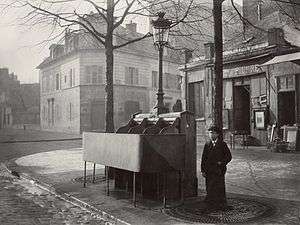 A pissoir with three stalls, Paris, c1865
A pissoir with three stalls, Paris, c1865- Vespasienne Arago, the one surviving Parisian pissoir.
 Elevation, section and plan drawings of an octagonal pissoir in Berlin, 1896
Elevation, section and plan drawings of an octagonal pissoir in Berlin, 1896 Cafe Achteck, Berlin, converted to male and female toilets
Cafe Achteck, Berlin, converted to male and female toilets- Amsterdam 'Plaskrul'
_1923.jpg) Brick pissoir, Deventer, Arnhem, Netherlands, 1923
Brick pissoir, Deventer, Arnhem, Netherlands, 1923- Pissoir, Hütteldorf, Vienna, 1936
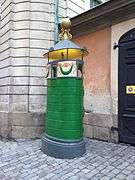 A pissoir close to the royal castle in Gamla Stan, Stockholm, Sweden
A pissoir close to the royal castle in Gamla Stan, Stockholm, Sweden%2C_2011%2C_Urinol._(5925305117).jpg) Pissoir in Lisbon
Pissoir in Lisbon Historic cast-iron urinal at Colyford station, England
Historic cast-iron urinal at Colyford station, England Cast iron urinal Melbourne
Cast iron urinal Melbourne Pissoir in Copenhagen
Pissoir in Copenhagen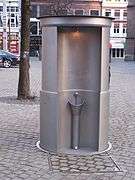 A retractable pissoir in The Hague
A retractable pissoir in The Hague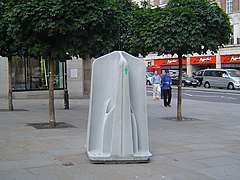 Plaskruis in London
Plaskruis in London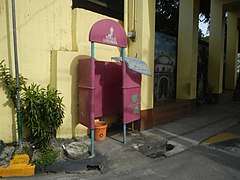 MMDA Street Urinal in Pateros, Metro Manila, Philippines
MMDA Street Urinal in Pateros, Metro Manila, Philippines
Notes
- Jaggard, David (27 March 2012). "The Flow of History: The Mercifully Dwindling Presence of the Parisian Pissoir". Paris Update. Archived from the original on 20 July 2016. Retrieved 18 July 2016.
- Fierro 1996, p. 1177.
- Pike 2005, p. 234.
- Ress 2006.
- Bärthel, Hilmar (2000): "Tempel aus Gusseisen: Urinale, Café Achteck und Vollanstalten", Berlinische Monatsschrift Heft 11
- "Café Achteck - Berlin's Green Pissoir". Berlin Love. 2017-11-13. Retrieved 2019-11-02.
- "Wiens letzte Öl-Klos werden saniert". wien.orf.at (in German). 2017-11-14. Retrieved 2019-11-02.
- "Wiener Pavillon Pissoir, 1908 – Technisches Museum Wien". www.technischesmuseum.at. Retrieved 2019-11-02.
- "street urinals". HERITAGE GROUP WEBSITE for the CHARTERED INSTITUTION of BUILDING SERVICES ENGINEERS. Retrieved 2019-11-02.
- "Cast Iron Street Urinals - Group". Victorian Heritage Database.
- "The Pee Pod - the place to pee in Milton Keynes!". BBC News, 15 June 2010.
- "Edinburgh to trial 'pee pod' street urinals". BBC News, 24 November 2010.
- Salzmann, Claudia. "Frauen-Pissoir: Kein leichtes Unterfangen". Berner Zeitung, 18 July 2011 (in German).
Bibliography
- Fierro, Alfred (1996). Histoire et dictionnaire de Paris. Robert Laffont. ISBN 2-221-07862-4.CS1 maint: ref=harv (link)
- Pike, David L. (2005). Subterranean Cities: The World Beneath Paris and London, 1800-1945. Cornell University Press. ISBN 978-0-801-47256-5.CS1 maint: ref=harv (link)
- Ress, Paul (2006). "The Vanashing Vespasienne". Shaggy Dog Tales: 58 1/2 Years of Reportage. Xlibris. pp. 49–51. ISBN 978-1-450-09805-2.CS1 maint: ref=harv (link)
External links
